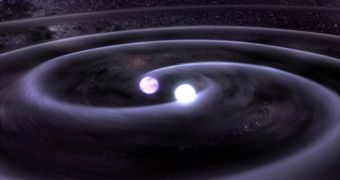During a new investigation, an international team of researchers provide the first evidences of detecting the effects of gravitational waves, ripples in spacetime predicted by Albert Einstein's theory of general relativity. The discovery was made by studying a white dwarf binary system.
Even though theoretical data on these waves abound, detecting them in practice is an extremely complex task, since these distortion ripples are tremendously large. Therefore, if a satellite system were to look for it, its spacecraft would have to be extremely far away from each other.
The first indirect evidences of gravitational waves were obtained years ago, by using radio signals from a pulsar-neutron star binary system. Through careful measurements of the signals' characteristics, a team was able to observe the rippling of spacetime, and its leader won a Nobel Prize for it.
In the new study, astronomers were able to produce similar results, except using optical wavelengths recorded from a white dwarf binary system. The latter is a binary star system made up of two white dwarfs, the remnants of Sun-sized stars that are now burning helium instead of hydrogen.
“This result marks one of the cleanest and strongest detections of the effect of gravitational waves,” comments Smithsonian Astrophysical Observatory (SAO) expert and team member, Warren Brown.
He explains that SDSS J065133.338+284423.37 (J0651 for short), as the binary system is called, was discovered last year, and was immediately made into a popular astronomical target. What is very interesting about this system is that its members orbit each other in less than 13 minutes.
This means that they are very close to each other, about one third of the distance between the Earth and the Moon. Under Einstein's famous theory, massive objects moving so close and fast to each other should wrap space around them, producing ripples that then travel through the Universe.
“Every six minutes the stars in J0651 eclipse each other as seen from Earth, which makes for an unparalleled and accurate clock some 3,000 light-years away,” University of Texas in Austin graduate student and lead study author, J.J. Hermes, explains.
“Compared to April 2011, when we discovered this object, the eclipses now happen six seconds sooner than expected,” University of Oklahoma astronomer and team member, Mukremin Kilic, says.
“This is a general relativistic effect you could measure with a wrist watch,” Brown concludes, in a statement published by the Harvard-Smithsonian Center for Astrophysics (CfA).

 14 DAY TRIAL //
14 DAY TRIAL //